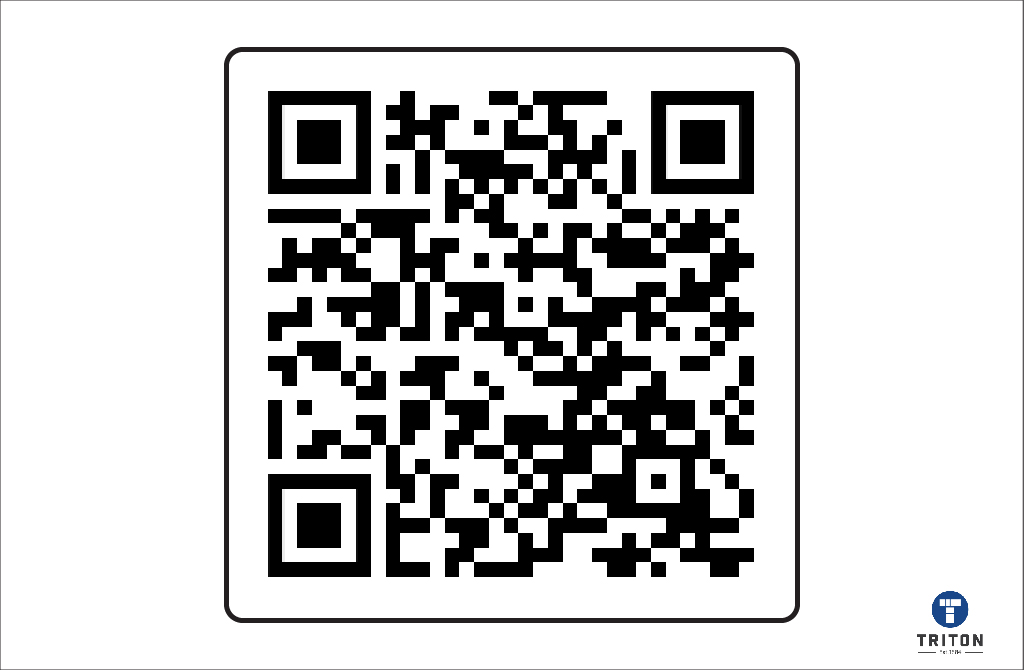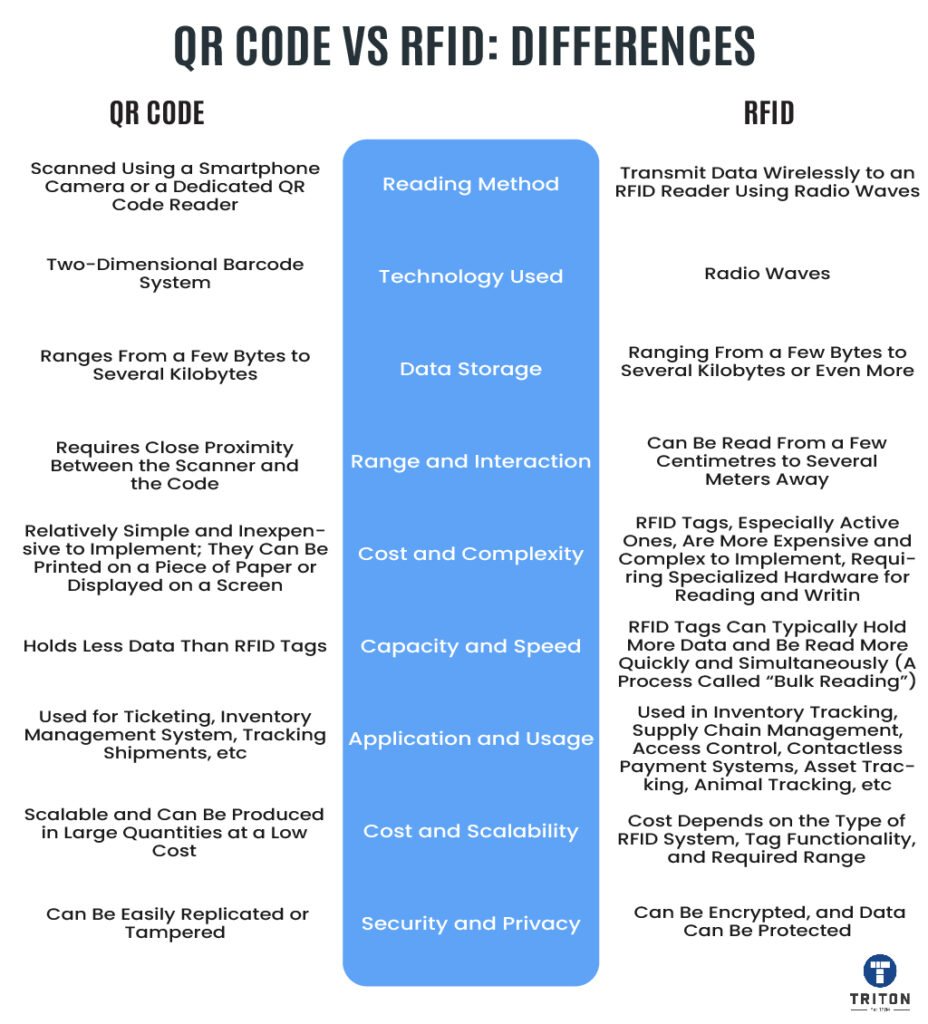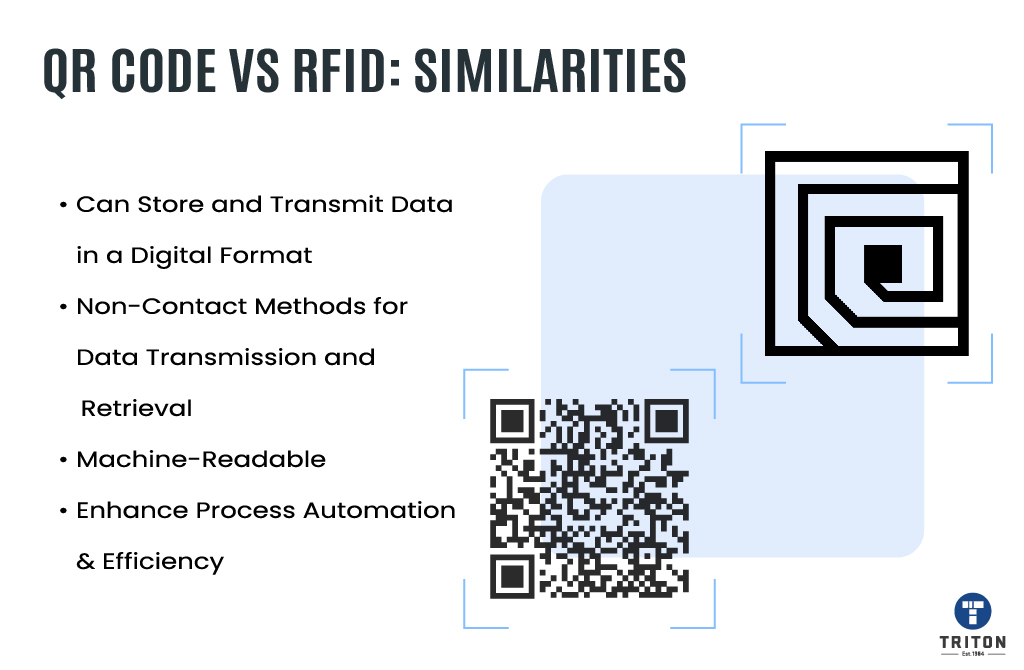
In the world of product inventory management, two technologies have become popular RFID tags and QR codes. While both serve the purpose of inventory tracking, they operate on entirely different principles, each with advantages, disadvantages and applications.
This article aims to provide an overview of the two technologies, their similarities and differences.
So, let’s get started.

A QR code, short for Quick Response code, is a two-dimensional barcode with black squares arranged on a white background.
QR codes were developed in 1994 by Denso Wave, a Japanese company. They became popular due to their ability to store large amounts of data and be quickly scanned by smartphones and other devices.
QR codes can encode various types of information, such as text, URLs, contact details, Wi-Fi network information, and more. They use a combination of patterns and alphanumeric characters to represent the encoded data.
When a QR code is scanned via a QR code reader or a smartphone, the encoded information is extracted and presented to the user.
QR codes provide easy access to websites, promotional offers, product information, and more. You would have seen them on event tickets, business cards, packaging, and even restaurant menus, enabling users to quickly access additional content and perform specific actions like collecting points on the purchase of products.
Check our guide on what is a QR code, how do QR codes work and QR code best practices.
A few advantages of QR code systems are:
A few limitations of QR codes are as follows:
RFID (short for Radio-Frequency Identification) allows the wireless identification and tracking of objects or individuals using radio waves by means of tags attached to them. This technology enables data transmission from an RFID tag to an RFID reader device.
It consists of three main components: RFID tags, RFID readers, and a backend system for data processing.
RFID tags are small electronic devices comprising a microchip and an antenna. The microchip stores unique identification data, while the antenna facilitates communication by transmitting and receiving radio signals.
RFID readers emit radio waves and communicate with RFID tags within their range. When an RFID tag enters the reader’s vicinity, the reader’s radio waves energise the tag and initiate communication.
The backend system forms the infrastructure for processing the data collected from RFID readers. It includes databases, software applications, or cloud-based platforms that manage and analyse the gathered information.
RFID finds applications across various industries, including retail, logistics, healthcare, transportation, access control, and asset tracking.
At Triton, we offer some of the best RFID printers including the Zebra ZT411R, Honeywell PX4E, Zebra ZT231, and Honeywell PM45. Check out the article on what is an RFID Printer.
RFID systems offer the following advantages:
A few limitations of RFID are as follows:

QR codes and RFID offer efficient ways to encode, store, and retrieve information. However, they differ in their underlying principles and applications.
Some of the key differences between a QR code and an RFID are:
QR codes use a two-dimensional barcode system of black squares arranged on a white background. It stores information in a visual pattern that can be scanned and decoded by a smartphone or dedicated QR code reader. The data capacity of a QR code can range from a few bytes to several kilobytes.
RFID uses radio waves to transmit data from an RFID tag to an RFID reader. RFID tags can store more data than QR codes, ranging from a few bytes to several kilobytes or even more.
QR codes are scanned using a smartphone camera or a dedicated QR code reader. The user must position the QR code within the scanner’s viewfinder to decode and read the information.
RFID tags transmit data wirelessly to an RFID reader using radio waves. The reader sends out radio signals, and when the tag enters its range, it receives and responds with the stored information.
QR codes require close proximity between the scanner and the code itself. Typically, the user must hold their smartphone or scanner within a few inches of the QR code for successful scanning.
RFID tags have a varying range depending on the frequency and power of the reader. They can be read from a few centimetres to several metres away, allowing for non-contact and automated data capture.
QR codes are commonly used in marketing and advertising to quickly access websites, product information, or promotions. They are also used for ticketing, inventory management systems, and tracking shipments.
RFID technology is used in various industries for tracking and identification purposes. It is widely used in inventory tracking, supply chain management, access control, contactless payment systems, asset tracking, and animal tracking.
QR codes are inexpensive to generate and can be easily printed on various surfaces, such as paper, labels, or packaging materials. They are scalable and can be produced in large quantities at a low cost.
RFID technology involves using specialised tags and readers, which can be more expensive than QR codes. The cost depends on the type of RFID system, tag functionality, and required range. However, RFID systems can be more efficient and scalable in certain applications, particularly for automated tracking and large-scale operations.
QR codes can be easily replicated or tampered with, posing a security risk if used for sensitive information. However, encryption and secure QR code generation methods can enhance security.
RFID tags can be more secure as they can be encrypted, and data can be protected through access control mechanisms. However, unauthorised reading of RFID tags is a potential privacy concern, as someone with an RFID reader can access the information without the tag owner’s knowledge.

Along with differences, QR codes and RFID also share some similarities. Some of these are:
No, RFID scanners cannot read QR codes. RFID (Radio Frequency Identification) and QR codes (Quick Response codes) are different technologies operating on different principles.
RFID scanners use radio waves to communicate with RFID tags containing a microchip and an antenna. These scanners can read the unique identifier or data stored in the RFID tag when they come into proximity.
On the other hand, QR codes are two-dimensional barcodes that can be scanned and decoded using a smartphone camera or a dedicated QR code reader.
Whether RFID or QR code is better depends on the specific use case and requirements.
RFID is advantageous for contactless reading, longer read range, durability, and larger data capacity. However, it tends to be more expensive than QR and has limited compatibility.
QR codes are cost-effective, widely accessible, versatile, and easy to use with smartphones. They are suitable for close-range scanning but have limitations in terms of physical contact and read range.
Ultimately, the choice between RFID and QR code depends on the specific needs of the application.
In conclusion, QR codes and RFID offers unique features and capabilities for data encoding, transmission, and retrieval.
The choice between the two depends on the specific use case, desired functionality, budget considerations, and the level of security and scalability needed. By leveraging the unique features of QR codes and RFID, organisations can enhance data management, streamline processes, and provide engaging customer experiences.
Melbourne
Brisbane
Phone 1300 558 438
Live Chat – Widget below
Melbourne
Brisbane
Phone 1300 558 438
Live Chat – Widget below